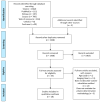Tissue Is the Issue: A Systematic Review of Methods for the Determination of Infarct Volume in Acute Ischaemic Stroke
- PMID: 40563756
- PMCID: PMC12190565
- DOI: 10.3390/brainsci15060583
Tissue Is the Issue: A Systematic Review of Methods for the Determination of Infarct Volume in Acute Ischaemic Stroke
Abstract
Background and aims: Recent advances in acute stroke interventions have highlighted the importance of accurate determination of infarct volume in the evaluation of acute stroke patients, carrying important prognostic and therapeutic implications for treatment planning, outcome prediction, and evaluation of the success of therapeutic interventions. However, there is no consensus on the methodologies employed to measure cerebral infarct volume. We aimed to assess the reproducibility and reliability of methods employed in the clinical determination of infarct volume in acute ischaemic stroke.
Methods: We carried out a systematic review of studies assessing methodologies for the determination of infarct volume in the acute phase (<24 h). We searched Medline PubMed, Scopus, Cinahl, Cochrane Library, Web of Science, and Embase for studies examining image-based diagnosis of acute ischaemic stroke < 24 h by CT or MRI. Data on patient cohorts, imaging type, time from symptoms onset, methodologies and quantification strategies, rater reliability, accuracy, sensitivity, and specificity were compared.
Results: We identified eighteen eligible studies with a total of 3298 ischaemic stroke patients assessing a variety of manual, semi-automated, and fully-automated methods. The ABC/2 method was found to be highly reliable, reproducible, and accurate, and provides the best manual estimate of infarction, but has a tendency to under- or overestimate infarct volume. Semi-automated and automated approaches with user refinement showed excellent inter-rater and intra-rater correlation. However, differences in operating algorithms and lack of standardisation of image acquisition parameters, quality, and format may impact performance and reproducibility.
Conclusions: Of all methods, automated and semi-automated approaches utilising rater judgment and refinement represent the most robust approaches, with semi-automated tools demonstrating consistent and repeatable results. We recommend a standardised reporting of study methodologies for the accurate interpretation and comparison of efficacy of therapeutic interventions and patient outcomes, especially in a multi-centre setting. This may allow for more effective evaluation of stroke therapies and accelerate ischaemic stroke treatment decisions.
Keywords: infarct measurement; infarct volume; ischaemic stroke; non-contrast computerised tomography; stroke.
Conflict of interest statement
The authors declare no conflicts of interest.
Figures
Similar articles
-
Comparative Analysis of the ABC/2 Score and e-ASPECTS Software in the Determination of Acute Ischaemic Stroke Volume from Non-Contrast CT.Brain Sci. 2025 May 24;15(6):560. doi: 10.3390/brainsci15060560. Brain Sci. 2025. PMID: 40563732 Free PMC article.
-
Systemic pharmacological treatments for chronic plaque psoriasis: a network meta-analysis.Cochrane Database Syst Rev. 2021 Apr 19;4(4):CD011535. doi: 10.1002/14651858.CD011535.pub4. Cochrane Database Syst Rev. 2021. Update in: Cochrane Database Syst Rev. 2022 May 23;5:CD011535. doi: 10.1002/14651858.CD011535.pub5. PMID: 33871055 Free PMC article. Updated.
-
Remote ischaemic conditioning for preventing and treating ischaemic stroke.Cochrane Database Syst Rev. 2018 Jul 5;7(7):CD012503. doi: 10.1002/14651858.CD012503.pub2. Cochrane Database Syst Rev. 2018. PMID: 29974450 Free PMC article.
-
Antidepressants for pain management in adults with chronic pain: a network meta-analysis.Health Technol Assess. 2024 Oct;28(62):1-155. doi: 10.3310/MKRT2948. Health Technol Assess. 2024. PMID: 39367772 Free PMC article.
-
Drugs for preventing postoperative nausea and vomiting in adults after general anaesthesia: a network meta-analysis.Cochrane Database Syst Rev. 2020 Oct 19;10(10):CD012859. doi: 10.1002/14651858.CD012859.pub2. Cochrane Database Syst Rev. 2020. PMID: 33075160 Free PMC article.
References
Publication types
LinkOut - more resources
Full Text Sources


